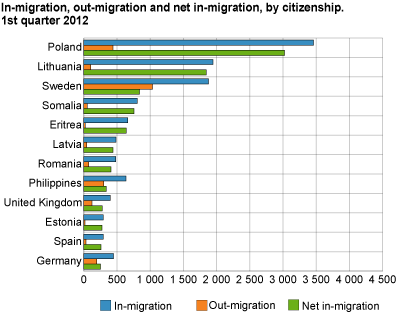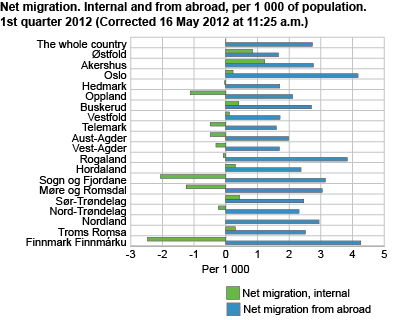Content
Published:
This is an archived release.
And then we were 5 million 3 thousand
Norway's population reached 5 003 000 on 1 April 2012, and increased by 17 100 in the first quarter. This is the greatest population growth ever registered in any first quarter. Twenty per cent of this was due to the birth surplus, and 80 per cent to the net immigration.
The population increase of 17 100 in the first quarter was very similar to that of 2011; 350 more were born and 450 more died, so the birth surplus decreased by 100. Immigration decreased by 2 100 and emigration by 2 300, so net immigration increased by 200. The birth surplus totalled 3 450 and net immigration 13 600. In the years up to 2006, birth surplus constituted between 40 and 70 per cent of the population growth of the first quarter. Nevertheless, the birth surplus of this year’s first quarter is among the highest registered during the last three or four decades. Recent calculations indicate that Norway reached 5 000 000 inhabitants on 15 March, and that the date estimated by Statistics Norway in February - 19 March - was very close.
A total of 14 750 children were born, and the average for the last 25 years thus reached 14 700. The figures have varied between 13 500 and 15 500 and been very stable for this period. A total of 11 300 died, whereas the average for the same period was 11 600. The resulting birth surplus of 3 450 for the first quarter was slightly higher than the average for the last 25 years, which was 3 100. As shown in figure 1, the changes in population growth have been due to the changes of the size of net immigration.
Seven out of ten immigrants were Europeans
The net immigration of 13 600 in the first quarter is the highest ever registered in a first quarter. The number of immigrants decreased by 2 100 last year to the current 22 300, but emigration decreased by 2 400 to 6 500, and this resulted in an increased net immigration.
Of immigrants having other citizenship than Norwegian, 69 per cent had European citizenship. Almost half of these; 6 200, came from Poland or the Baltic countries. Immigration from the countries in Southern Europe experiencing economic problems - such as Greece, Spain, Portugal and Italy - increased, but the figures are still low, up from 500 last year to 650 this year.
The number of Swedish citizens arriving decreased the most and reached 1 900; down from 4 000 last year. Last year’s figure was particularly high, partly because some 1 000 more Swedes were registered in January that year compared to the years before - and this year - in connection with changed routines for receipt of tax cards.
Citizens of countries where flight is an important reason for emigration are registered as immigrants when they receive their residence permit. The number of refugees arriving is therefore not directly comparable to the number of immigrants. Immigration among Somali citizens doubled, and reached 800. Seven hundred Eritrean citizens also immigrated, and these two groups constituted the fourth and fifth largest groups in the first quarter.
Population increase in all counties, but to a varying degree
Oslo stood out in terms of population increase in the first quarter. Its growth of close to 4 000 was not far from a quarter of Norway’s total growth. Oslo’s birth surplus of 1 300 was more than one third of the country’s surplus. In relative terms, Oslo and Rogaland are the two counties with the largest surplus, whereas the inland counties Hedmark and Oppland had the largest birth deficit compared to the population size.
Migration gain from abroad in all counties
All counties had a migration gain from abroad. The two counties Oslo and Akershus had a total gain of 4 100, down 1 000 from last year. In Rogaland and Hordaland the combined gain was 2 900, up 1 000 from 2011. The migration gain totalled 13 600 and offset the birth deficit and domestic migration loss in many counties.
Eleven counties had a domestic migration loss, whereas eight had a domestic migration gain, the largest of which was in Akershus with 700.
Population increase in 281 municipalities
A total of 281 of the 429 municipalities had a population increase in the first quarter, whereas 140 had a decrease and 8 saw no change. As in previous years, the population increased in centrally situated municipalities whereas less central areas experienced a migration loss and birth deficit. More than half of the 20 municipalities with the largest birth surplus were situated in Rogaland and Hordaland.
The statistics is published with Population.
Contact
-
Statistics Norway's Information Centre
E-mail: informasjon@ssb.no
tel.: (+47) 21 09 46 42



